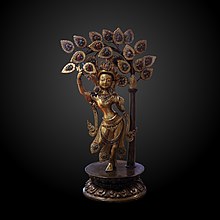Maya | |
|---|---|
 | |
| Born | |
| Died | Kapilavastu, Shakya Kingdom |
| Other names | Mahamaya |
| Occupation | Queen of Shakya Kingdom |
| Predecessor | Kaccanā |
| Spouse | Śuddhodana |
| Children | Siddhartha Gautama (the Buddha) |
| Parent(s) | Anjana (father), Sulakṣañā (mother) |
| Relatives | Suppabuddha and Dandapāni (brothers), five sisters including Mahapajapati Gotami |
| Dynasty | Shakya Republic |
Maya (/ˈmɑːjə/; Devanagari: माया, IAST: māyā), also known as Mahāmāyā and Māyādevī, was the queen of Shakya and the birth mother of Gautama Buddha, the sage on whose teachings Buddhism was founded. She was the wife of Śuddhodana, the king of the Shakya kingdom. She died days after giving birth and the Buddha was raised by her sister, Mahāpajāpatī Gotamī, who became the first Buddhist nun ordained by the Buddha.[2][3]
In the Buddhist Commentaries, Maya was on a traditional journey to her familial home in Devadaha where she would give birth, but her labor started as they were in Lumbini. The Buddha was then born in the gardens and Maya died soon after the birth of the Buddha, generally said to have been seven days afterwards.
Maya was then reborn, or came to life again, in a Buddhist heaven, a pattern that is said to be followed in the births of all Buddhas.[2] Thus Maya did not raise her son, who was instead raised by her sister and his maternal aunt, Mahapajapati Gotami.[2] Maya would, however, on occasion descend from Heaven to give advice to her son.[2]
Māyā (माया) means "skillful creator" in Sanskrit.[4] Māyā is also called Mahāmāyā (महामाया, "Great Māyā") and Māyādevī (मायादेवी, "Queen Māyā"). In Chinese, she is known as Móyé-fūrén (摩耶夫人, "Lady Māyā"), in Tibetan she is known as Gyutrulma and in Japanese she is known as Maya-bunin (摩耶夫人). Also, in Sinhalese she is known as මහාමායා දේවී (Mahāmāyā Dēvi).
- ^ "La reine Maya Devi donnant naissance au prince Siddhârta, le futur Buddha Cakyamuni". Réunion des Musées Nationaux. Retrieved November 14, 2020.
- ^ a b c d Buddhist Goddesses of India by Miranda Shaw (Oct 16, 2006) ISBN 0-691-12758-1 pages 45-46
- ^ History of Buddhist Thought by E. J. Thomas (Dec 1, 2000) ISBN 81-206-1095-4 pages
- ^ Burrow, T. (1980). "Sanskrit "mā-" 'To Make, Produce, Create'". Bulletin of the School of Oriental and African Studies, University of London. 43 (2): 311–328. ISSN 0041-977X.